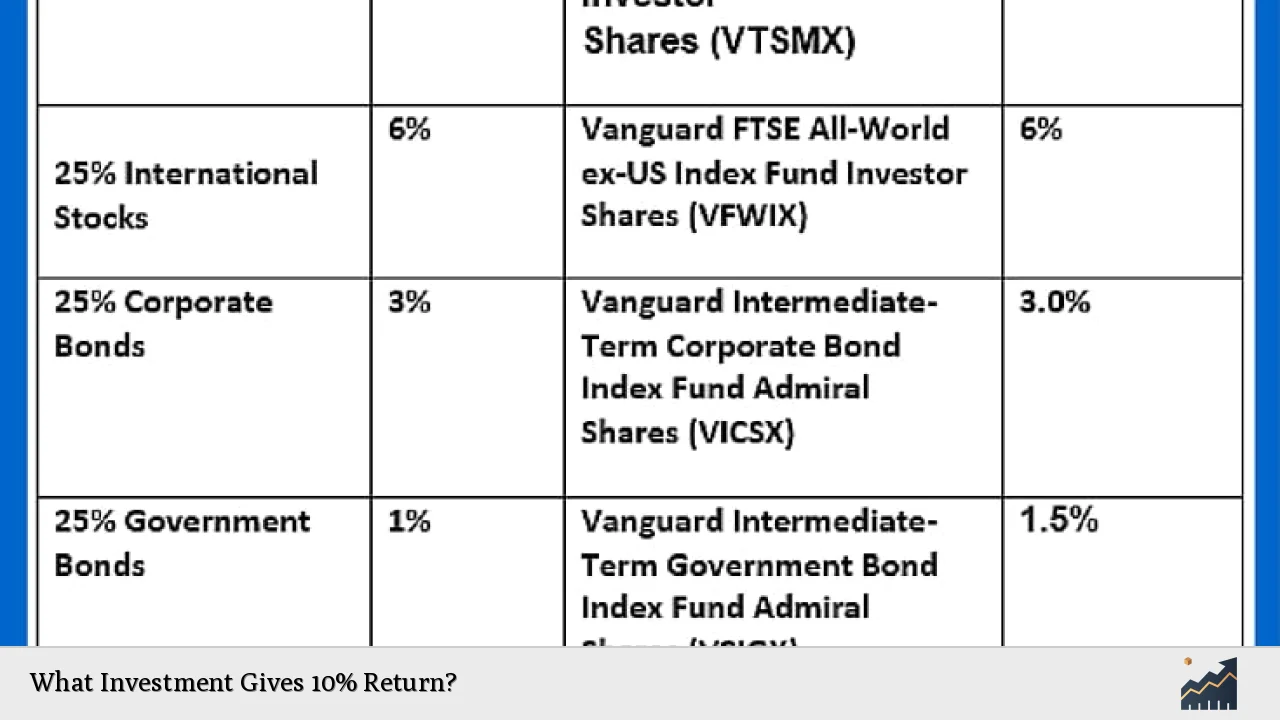Achieving a 10% return on investment is an attractive goal for many investors seeking to grow their wealth. While no investment can guarantee a specific return, several options have historically provided average annual returns of 10% or more. However, it’s crucial to understand that higher potential returns often come with increased risk. Let’s explore some investments that have the potential to deliver a 10% return, along with their associated risks and considerations.
| Investment Type | Potential Return |
|---|---|
| S&P 500 Index | 10% (historical average) |
| Real Estate | 10.3% (25-year average) |
| Private Credit | 8-12% (typical range) |
| Individual Stocks | Varies (potentially >10%) |
It’s important to note that past performance does not guarantee future results. Investors should carefully consider their risk tolerance, investment goals, and time horizon before making any investment decisions. Let’s delve deeper into some of the most promising options for achieving a 10% return on investment.
Stock Market Investments
The stock market has historically been one of the most reliable ways to achieve long-term returns of around 10%. While individual years can see significant fluctuations, the S&P 500 index has delivered an average annual return of approximately 10% over the past century. This makes index funds and exchange-traded funds (ETFs) that track the S&P 500 an attractive option for investors seeking consistent long-term growth.
Investing in individual stocks can potentially yield even higher returns, but it comes with increased risk and requires more research and expertise. Some growth stocks have delivered returns well above 10% annually, but picking individual winners consistently is challenging. A diversified portfolio of carefully selected stocks can help balance risk while still aiming for above-average returns.
For those willing to take on more risk, small-cap stocks have historically outperformed large-cap stocks over the long term. Between 1926 and 2018, small stocks returned an average of 11.8% annually, compared to 10% for large stocks. However, small-cap stocks are generally more volatile and may experience more significant short-term losses.
Real Estate Investments
Real estate has long been a popular investment for those seeking substantial returns. According to the National Council of Real Estate Investment Fiduciaries (NCREIF), private commercial real estate properties held for investment purposes have delivered average annualized returns of 10.3% over 25 years, slightly outperforming the S&P 500.
Investors can gain exposure to real estate through various methods:
- Direct property ownership
- Real Estate Investment Trusts (REITs)
- Real estate crowdfunding platforms
- Real estate mutual funds or ETFs
Each approach has its own set of advantages and risks. Direct property ownership can provide the highest potential returns but requires significant capital and hands-on management. REITs offer a more liquid and passive way to invest in real estate, often providing steady income through dividends.
Private Credit Investments
Private credit has gained popularity among investors seeking higher yields in a low-interest-rate environment. This alternative asset class involves lending to private companies or participating in privately negotiated debt financing. Private credit investments typically offer returns in the range of 8-12% annually, making them an attractive option for those aiming for a 10% return.
Some key advantages of private credit investments include:
- Higher yields compared to traditional fixed-income investments
- Potential for steady income streams
- Diversification benefits for a portfolio
However, private credit investments often come with higher risk and lower liquidity compared to public market debt. They may also have higher minimum investment requirements and be subject to longer lock-up periods.
Alternative Investments
For investors willing to explore less traditional options, several alternative investments have the potential to deliver returns of 10% or more:
Fine Art
The art market has shown strong long-term performance, with contemporary art averaging annual returns of 7.5% since 1985. However, carefully curated art portfolios have the potential to deliver even higher returns. Some art investment platforms claim to have achieved average annual returns exceeding 20% for their clients.
Peer-to-Peer Lending
P2P lending platforms connect borrowers with individual lenders, offering the potential for high returns. While returns can vary widely based on the risk level of loans, some investors have reported returns of 10% or more from P2P lending. However, this investment comes with significant risk, including the potential for borrower defaults.
Cryptocurrency
The cryptocurrency market has seen explosive growth in recent years, with some digital assets delivering astronomical returns. However, the crypto market is extremely volatile and speculative. While potential returns can be high, investors should be prepared for the possibility of significant losses.
Strategies for Achieving 10% Returns
To maximize your chances of achieving a 10% return on investment, consider the following strategies:
- Diversify your portfolio across multiple asset classes
- Reinvest dividends and capital gains to compound returns
- Take a long-term investment approach
- Regularly rebalance your portfolio
- Consider dollar-cost averaging to mitigate market timing risk
- Stay informed about market trends and economic conditions
Remember that achieving consistent 10% returns requires careful planning, risk management, and often a willingness to weather short-term volatility for long-term gains.
FAQs About What Investment Gives 10% Return
- Is a 10% return on investment realistic?
Yes, a 10% return is realistic over the long term, but it often requires taking on some level of risk. - What is the safest investment with the highest return?
Generally, index funds tracking the S&P 500 offer a good balance of safety and potential for high returns. - How can I get a guaranteed 10% return on my money?
There are no guaranteed 10% returns, but diversifying across stocks, real estate, and bonds can increase your chances. - What investment has the highest return in 2025?
It’s impossible to predict with certainty, but technology and renewable energy sectors show strong growth potential. - How much money do I need to invest to make $1000 a month?
Assuming a 10% annual return, you’d need to invest approximately $120,000 to generate $1000 monthly.

